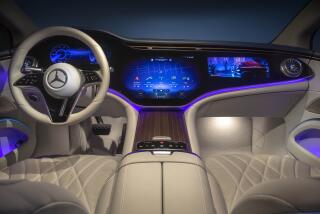Voice commands while driving still distracting and risky, AAA study says
- Share via
Drivers who use hands-free commands remain distracted for up to 27 seconds after they have made a call or changed music, according to the AAA Foundation for Traffic Safety.
Working with researchers at the University of Utah, the auto club’s safety branch found that this lingering distraction raises new concerns for using phones and vehicle infotainment systems.
“Overwhelming scientific evidence concludes that hands-free is not risk-free,” said Marshall Doney, AAA’s chief executive.
The distraction continues even when a motorist turns attention back to the road and has both hands on the steering wheel, the AAA report said.
“The results indicate that motorists could miss stop signs, pedestrians and other vehicles while the mind is readjusting to the task of driving,” said Peter Kissinger, chief executive of the AAA Foundation for Traffic Safety.
AAA and the university looked at 10 cars from the 2015 model year and three phone systems and discovered that not all systems are equally distracting.
Rating mental distraction on a five-point scale, with a lower score being better, the researchers found the best performing system was on Chevrolet’s Equinox crossover. It had a rating of 2.4.
The worst was the Mazda 6 sedan, with a cognitive distraction rating of 4.6.
Mazda said it already has improved the system for it 2016 model year lineup, incorporating lessons learned from the previous-generation system that AAA tested.
“We strove to develop a driver-focused entertainment system interface with minimal distraction from that primary job,” said Jeremy Barnes, a Mazda spokesman. “Given the relentless pace of technology advancement, we’re always looking for new ways to make that interface between user and machine smoother and more intuitive.”
The other cars tested and their ratings were the Buick LaCrosse, 2.4; Toyota 4Runner, 2.9; Ford Taurus, 3.1; Chevrolet Malibu, 3.4; Volkswagen Passat, 3.5; Nissan Altima, 3.7; Chrysler 200c, 3.8; and Hyundai Sonata, 3.8.
AAA judged a mental distraction rating of 2 or higher to be potentially dangerous while driving. At a speed of 25 mph, cars travel the length of nearly three football fields during a 27-second distraction time. Even with the better systems — which leave drivers with about 15 seconds of distraction — cars travel about half that distance.
Researchers also examined the effect of using voice commands to control phone systems while driving.
The Google Now system performed best with a distraction rating of 3.0, while Apple Siri and Microsoft Cortana earned ratings of 3.4 and 3.8, respectively.
But using voice commands and phones to send texts created extra distraction. While sending voice-activated texts, Google Now rated as a category 3.3 distraction, while Apple Siri and Microsoft Cortana rated 3.7 and 4.1, respectively.
The University of Utah researchers used 257 drivers ages 21 to 70 to research the car systems, while 65 others were used to test the phones.
The auto club is sharing the findings with the car and phone industries with the goal of developing systems that are no more distracting than listening to the radio or an audiobook, Doney said.
“Given that the impairing effects of distraction may last much longer than people realize,” he said, “AAA advises consumers to use caution when interacting with these technologies while behind the wheel.”
For more automotive news, follow me on Twitter (@LATimesJerry) and Facebook.







